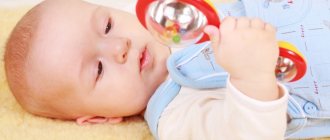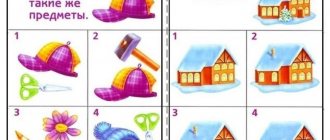The next stage in the baby’s development has arrived: the baby is exactly 5 months old!
What to pay attention to at this age?
What are the features of the psychological, physical and intellectual “growing up” of a five-month-old baby?
The following article talks about how to develop a child at 5 months, how to deal with him and other related issues.
Responsible parents are always interested in knowing what they should pay attention to when raising their children.
What should a 5 month old baby be able to do?
At the age of five months, a baby usually behaves as if there were no bones in his body at all: lying on his back, he pulls his legs towards his face and takes his toes into his mouth. If you lay him on his tummy, he will easily lift his chest up and bend his back down, taking the “seal” pose. According to the observations of pediatricians and teachers, five-month-old children can demonstrate other skills.
5 Month Baby Skills Chart
At this age, unconditioned reflexes disappear. All further actions in children occur consciously. There is an approximate table of what a baby should be able to do at the age of 5 months, with which parents are advised to compare the development of their baby.
| Physical skills (gross motor skills) |
|
| Fine motor skills |
|
| Emotional Skills |
|
| Hearing skills |
|
| Visual skills |
|
| Speech skills |
|
What a baby should be able to do at 5 months, according to the observations of pediatricians in Russia and the WHO, not all five-month-old children can and can do. For example, many babies at this age are not yet able to roll over, confidently rest on their legs, hold the hands of an adult, or pronounce syllables. This lag is within the normal range. The main thing is that the baby is outwardly healthy and cheerful.
Anastasia, mother of 10-month-old Sasha: “At 5 months old, my son was already turning on his side, lying on his stomach and resting on his outstretched arms on his palms, but he couldn’t turn over. But literally a month later, my son easily spun from his back to his stomach and back, and also sat confidently. Our baby also began to speak the first syllables later – at the end of the sixth month of life.”
For five-month-old children, an important indicator of physical health is their height and body weight.
Height and weight of a 5 month old baby
Depending on gender, healthy five-month-old babies weigh from 4.8 to 10.4 kg. WHO height and weight standards are determined by the following table:
Standards for girls (WHO)
Table symbols: P – height; B – weight.
| Very low | Short | Below the average | Average | Above average | High | Very tall | |||||||
| Height (cm) | Weight, kg) | Height | Weight | Height | Weight | Height | Weight | Height | Weight | Height | Weight | Height | Weight |
| 57,4 | 4,8 | 59,6 | 5,4 | 61,8 | 6,1 | 64,0 | 6,9 | 66,2 | 7,8 | 68,5 | 8,8 | 70,7 | 10,0 |
Standards for boys (WHO)
| Very low | Short | Below the average | Average | Above average | High | Very tall | |||||||
| Height (cm) | Weight, kg) | Height | Weight | Height | Weight | Height | Weight | Height | Weight | Height | Weight | Height | Weight |
| 59,6 | 5,3 | 61,7 | 6,0 | 63,8 | 6,7 | 65,9 | 7,5 | 68,0 | 8,4 | 70,1 | 9,3 | 72,2 | 10,4 |
In Russia, weight and dew standards are determined by the Moscow Research Institute of Pediatrics and Surgery.
For five-month-old babies they have the following meanings:
| Average height (cm) | Height range (cm) | Average weight (kg) | Weight range (kg) | |
| Girls | 63,9 | 62 — 67 | 7,2 | 6,2 — 8,0 |
| Boys | 66,9 | 65 — 69 | 7,8 | 7,0 — 8,4 |
For comprehensive development, it is recommended to engage in educational exercises and games with children every day. After all, before one year of age, children absorb information and master various skills faster than at any other period in their lives. It is very important not to waste time, which can be spent with enormous benefit for the health and intelligence of the younger generation.
Norms of weight gain and height by five months
Pediatricians evaluate the rate of physical development of a child up to one year, including weight gain and height. During this period, the baby can already weigh from 6,700 to 8,400 grams, and its height is from 64 to 68 centimeters. The child already weighs twice as much as at birth, and has gained 14-16 cm in height. The optimal monthly increase is about 600 grams, but the increase may be uneven across months. This depends on nutrition, the individual pace of development of the baby and other factors (during illness or teething, many refuse food and gain weight more slowly). After 5-6 months, the pace decreases if the child has already “created a reserve”, adding a kilogram per month. In this case, a monthly gain of about 300-400 grams is considered normal.
How to help your baby develop fully?
A. Schopenhauer noted: “A child’s hour is longer than an old man’s day.”
It is enough for mom to study just one hour daily for him to become more dexterous, skillful and intelligent. During this time, you can have time to do gymnastics, play and socialize. For useful leisure, you need to choose suitable activities.
Not every family has the opportunity to attend early childhood development centers. It is somewhat more difficult to solve the problem of how to develop a child of 5 months at home. Home development has its positive sides: mom and dad will be able to engage in various activities with the baby and play educational games together.
Trouble sleeping while mastering skills
As you learn new skills, you may experience sleep problems. Many babies refuse to nap during the day or may cry when falling asleep, which greatly prolongs the process of going to bed. Nighttime sleep can also become restless and restless. The baby can fidget for a long time, worry, and whine. These are age-related changes caused by new skills. Daytime nap time should not be delayed until the child is very tired. It’s also time to put your baby to bed not asleep, but falling asleep, so that he learns to fall asleep on his own.
Physical development (gross motor skills)
The simplest means of physical development of a baby is a set of gymnastic exercises.
Strengthening the muscles of the back and neck
To strengthen the muscles of the back and neck, it is useful for the baby to exercise on a fitball.
- Having laid the child on the ball with his stomach down, the mother holds him by the legs and slightly rolls the ball forward;
- holding the ball between her legs, the mother holds the baby under her arms, his legs resting on the ball. In this position, the mother allows the baby to “jump” on a soft surface;
- the mother places the child on the ball with his back and, holding him by the legs, allows him to bend along the surface of the ball;
- the mother places the baby on her tummy and, holding him by the legs, rolls the ball forward until the baby’s hands touch the floor. In the place where the baby's hands will approach the floor, you should put several toys. This will allow you to simultaneously develop the baby’s reaction and his ability to grasp objects with his hand.
Arm muscle training
Pull-ups will help make your arms stronger. The mother sits in front of the child lying on his back, takes his hands and gently pulls him up until he sits up. He allows the joyful baby to remain in this position for half a minute and puts him back on his back.
Strengthening leg muscles
Riding an imaginary bike
The mother takes the baby's legs, clasping them at the ankles, and makes movements one at a time, imitating riding a bicycle.
Jumping
The mother sits on the sofa and places the baby on her lap, holding him under her arms. The child himself will begin to push off from his mother’s feet with his feet, jumping.
Swimming
At home, kids can even swim. To do this, you need to fill the bath with water and, supporting the baby by the back or tummy, allow him to row with his arms and legs.
We are actively moving
The progress of motor activity is especially noticeable in a child, starting from the fifth month of life. Stronger muscles allow him to perform unimaginable somersaults - the baby turns from his back to his stomach and back, raises his head and shoulders, trying to sit down. Lying on his tummy, the child raises his head high, leans on his palms, changes his position, trying to reach for the toy.
At this stage, it is important to support the baby’s aspirations and prepare him for crawling, standing up and taking his first steps. What games will be useful for 5 month old children?
- “Slider” - place the baby on his tummy, place a toy in front of him so that he cannot reach it with his hand. Most likely, the baby will begin to swing, leaning on his palms, and will try to pull himself up on his arms to grab the toy. You can help the baby a little by creating a support under his feet with one hand, from which he will push off. At this moment, you should support the little one under the chest with your other hand.
- “Arms and feet” is a game for developing coordination of movements. Wear bright socks, a bracelet, or tie a bell on the baby’s feet. The toddler will try to grab the leg with his hands and pull it into his mouth.
- “Magic wand” - to play you need a wooden or plastic stick with a diameter of about 3 centimeters. Give the baby a good grip on it with both hands. Fix the baby's fists with your hand. Raise the stick slightly - the baby will tense the muscles of the back, arms, neck, abdomen, and will definitely sit down.
- “Let's go, let's go” - all children of this age love this kind of fun. Holding the baby on your lap, say: “Let's go, let's go to the forest for nuts. On a flat road, on a flat road (we make the baby bounce slightly). Over bumps, over bumps (we tilt the child in different directions). Buh... fell into the hole (Slightly lower the baby).”
With a five-month-old baby, you need to exercise daily, doing various exercises for the arms and legs. Massage is also very useful, and to the stroking movements you can add light pinching and rubbing of the muscles and skin.
Development of fine motor skills
If the child’s fingers are tightly clenched into a fist , before starting the game they need to be relaxed by massaging the hands:
- Grab your baby's arms by the elbow and shake them - this will relax the fingers.
- Take your child's hands by the wrists and shake them lightly. Stretch your wrists, then rub your palms.
Then you can start finger games.
Developmental games for 5 months should be aimed at stimulating the grasping of objects with the palm of the hand and the opposable thumb and the handling of small objects. Finger games are required at this age.
Rotate the massage ball in your palms
Place your child on your lap with their back to you. Take a massage ball slightly larger than a child's palm and place it in the baby's hands. Grasp the child’s palms with your palms and begin rotational movements: in a circle, along the palm and across.
Don't press too hard on your baby's arms! This can injure the joints or cause pain from the bulging elements.
Interesting sock
Take a bright children's sock and sew buttons, beads, and bells onto it. Put the sock on the left arm and watch the child’s reactions. He should begin to feel the new toy and small objects with his right hand. If this does not happen, show how it should be: bring the baby’s hand to the sock and touch the bells with his finger.
"Ding-ding bell"
You will need a bell and a clothespin. Tie the bell tightly to a clothespin and attach the crumbs to your clothes: on your sleeve, on your panties, on your toe. The baby should reach for the ringing bell and try to remove the clothespin.
Make sure your child doesn't pinch his finger; don't leave him alone with this toy!
Finger games
Take your baby's hand and use the fingers of one hand to stroke the palm of the other. Say the rhyme:
We will stroke our fingers, So, so and so! We'll rub our fingers, So, so and so!
We clench our fingers into a fist and unclench them one at a time, reading the poem:
This finger wants to sleep, This finger jumps into bed, This finger takes a nap, This finger is already asleep. Fingers stood up. Hurray! It's time to go to kindergarten!
Getting to know the world
At 5 months, the child strives to learn more and more about the world around him. The complex process of cognition involves the organs of vision, hearing and touch. The baby carefully examines objects, listens to sounds and speech, touches toys for a long time and tries them out.
Experts say that when playing, the intensity of a baby’s brain activity doubles. What to do with a little person?
- Exploring one's own body is of great interest to five-month-old babies. Therefore, the game “Birds-Birds” will come in handy: “Birds-Birds, where are Maksimka’s hands? (legs, tummy, ears, nose, etc.) - Here are Maksimka’s hands (we take them by the hands, shake them slightly). Ay, good!”
- Take a tour of the room. At the same time, show your baby different objects, talk about them and let him touch them: “These are curtains. They protect Antoshka's eyes from the sun. Touch them. Do you feel how soft and smooth they are?” Moreover, the objects must be completely different in shape, texture and purpose.
- Bring your baby to the mirror. At this age, he begins to recognize his reflection. You will see how long and intently the child peers at him, and then begins to smile: “Where is Nastenka? There's Nastenka. What a beautiful girl. What a big girl."
- Give your baby new tactile sensations - let him touch a piece of ice, then a warm bottle. At the same time, comment on his feelings. Let the little one dip his fingers in jelly or porridge. You can dip your small hand into finger paints and leave an imprint on the paper. Believe me, this game will surprise and delight the little man.
The elementary knowledge laid down by parents at this age will become basic and will remain with the child for life.
Emotional and social development of the child
Five-month-old babies know how to show joy and laugh. They react warily to a stranger. They distinguish the intonation of the voice and may burst into tears if they hear a stern or overly demanding tone.
Everyday activities and activities play an important role in the development of emotions and relationships between a child and an adult. Show emotions while feeding, bathing, dressing and other activities, and soon the baby will also begin to imitate you.
While swimming
When bathing the baby, we soap the arms, legs, head and finally the tummy, feigning surprise:
Here the water is cold, Here it’s lukewarm, Here it’s hot, And here it’s boiling water, boiling water!
We support the “revival complex”
Putting the baby on his back, shake him and tickle him, smiling and saying:
To the boy:
Oh, my son, wheat ear, azure flower, sweet piece!
To the girl:
Oh you, my girl, Golden squirrel, Sweet candy, Lilac twig!
Stimulating laughter
Raise the baby with outstretched arms, supporting the baby's chest with one and his pelvis with the other. Rock it up and down, saying:
Stomp, stomp, stomp, I'm going, I'm going, the way is long. Not in steps, not running, but riding on a stick! (I. Mikhailova)
Play mats: features and tips for choosing
Several educational activities for children 5-6 months old combine special rugs. There are a huge number of these on sale. For children up to six months old, compact rectangular rugs with sides are suitable. The key parameter when choosing a rug is the material. Such toys should be colorful and bright, but only safe dyes should be used in production. Arcs must be provided for attaching toys. Five-month-old babies are attracted to large pictures, musical buttons and textured elements.
Vision development
The baby is attracted to bright and colorful educational toys, so he plays with them with pleasure.
Watching a moving toy
Tie a ribbon to any new toy so that the child is not distracted by your hand. Lay the baby on his back, show him the toy, shake him. Move it in a circle, make sure that the baby follows it with his eyes. If he reaches for the toy, let him grab it himself. By watching the movement of the toy, the baby learns to fix his gaze and follow its movement.
Tumbler
Now on sale are not only classic tumbler girls, but also animals - bunnies, bears, ducklings. While playing with a tumbler, the baby learns to operate the toy and watch its melodious dance and swaying to the sides.
Hide and seek
Hide and seek games with disappearing toys develop your baby's curiosity and vision. Cover the toy with a handkerchief and ask: “Where did the bear hide?” Then remove the handkerchief and say in a joyful voice: “Here comes the bear!” A little later, the child will happily begin to remove the handkerchief himself.
"The horned goat is coming"
The baby already recognizes mom and dad. This game will teach you to recognize other family members. Bring your child to grandma or grandpa. Let them play “butts” with the baby, reading him a poem:
A horned goat is walking, a butted goat is walking: With its legs - stomp, stomp! With your eyes - clap-clap! Whoever doesn't eat porridge will be gored, gored!
Intellectual development of a five-month-old baby
The child’s brain eagerly absorbs all the information that comes to him, and your task is to provide the baby with new impressions, to come up with games that will teach him something new. There is no need to constantly keep your baby in a familiar environment and walk along the same route. Let every day give him new discoveries and show him how interesting the world around him is. In the summer, spread a blanket on the warm grass in the park or at the dacha, allow your baby to lie on it, touch the leaves, smell the flowers.
The child is already trying to tell you something. Start a conversation with him, show him how interested you are in the baby’s “story.” Clearly name several times each object that attracted his attention, the baby will also begin to make some sounds and try to speak in his own language. Tell him short fairy tales, read rhythmic poems, nursery rhymes, sing songs. Encourage your baby to talk, this is when his speech begins to develop. Games with your child, where you need to make different sounds, will be very helpful in this - growl, meow, ooh and groan together.
It's time to teach your child to recognize objects by their image. Buy him an educational mat with pictures of fruits, toys, and animals. Show him a real apple and a picture of it in the book and on the rug. Say “apple” clearly several times. The same can be done with a ball, cube, or toy bear. After some time, the baby will find and show the object that you name. Buy toys that can move, make sounds, or light up lights when pressed with your hand. At first, the baby will randomly clap his fist, then his movements will become conscious.
You can purchase various educational toys for children:
- development center;
- beads;
- sound cushions and mats;
- mobiles;
- rattles
No one will do household chores for you, but don’t leave your baby bored in the crib while you wash the dishes or prepare dinner - figure out what to do to occupy him during this time. There are special boxes on sale in which you can bring your child into the kitchen and place him on stools or a bench. You can attach it behind your back in a sling, then the baby will “help” you. Let him play with a spoon, allow him to touch the stream from the faucet, and constantly talk to your child. Tell us what delicious soup you prepare for dad, show how a dirty plate turns into a clean one.
Developing hearing
5 month old babies love to make sounds from a variety of objects. Even a simple rattle for them is no longer just a bright, rattling thing, but something like a primitive musical instrument. Often, while playing with her, the baby even sings along.
With the help of games, the baby's auditory perception develops.
Where does the sound come from?
Covering a switched-on musical toy with a diaper, the adult asks: “Where does the sound come from?” The baby listens to the music, looking for the source of the sound.
Tambourine
Sit on the floor and place your baby on your lap with his back to you. Take a tambourine and shake it to the child’s right. The baby should turn his head towards the sound. Bring the tambourine closer to the child and let him knock on the toy. This way he will learn to establish a relationship between his actions and outgoing sounds.
Learning to distinguish melodies
Perhaps the child does not yet understand the difference between a calm and a dancing melody. Teach him how to respond to happy music. Take the baby in your arms and dance with him, singing a song to the melody “In the garden or in the vegetable garden”:
On the green meadow Moths fly and from flower to flower they flutter merrily!
When bedtime approaches, sing a lullaby quietly while rocking your baby in your arms:
Bye-bye, bye-bye, You are a dog, don’t bark here, Whitepaw don’t whine, And don’t wake up (child’s name).
Let's talk
At 5 months, the baby begins to babble - pronouncing syllables with different intonations and in different keys. These are the beginnings of the little man's future speech. Parents must support and develop them in play activities with the baby.
- When playing with your child, sing him songs, tell him rhymes and nursery rhymes: “Ma-ma-ma-ma, mommy! Ba-ba-ba-ba, grandma! Doo-doo-doo-doo, pipe! Pa-pa-pa-pa, daddy! Mu-mu-mu-mu, little murochka! Such activities stimulate baby babble, teaching the baby to pronounce new syllables.
- Play “Ladushki” and “Magpie – White-sided” with your children. These games are good because in addition to the auditory analyzer, tactile sensations and fine motor skills are also involved, which together contribute to the development of speech.
- Finger games are very good: “One, two, three, four, five. The fingers went out for a walk. This finger is my grandfather's. This finger is a woman. This finger is mom. This finger is dad. But this finger is me. We are all a friendly family” (we bend the toddler’s fingers until they all clench into a fist).
- From 5 months you can already play with names - this will require different objects or images. When showing them, use simplified names: “Look, Anechka, this is a clock, tick-tock” or “This is a bee, zhu-zhu.” The child will quickly remember such simple words, and the next time you ask: “Where is the clock, where is the tick-tock?”, he will definitely reach for a toy or a picture with its image.
- Take a roll call - say a syllable that the child can already pronounce. The baby will begin to babble, repeating after you. Now try to pronounce a new combination of sounds, take a short pause so that the baby has time to comprehend and react, expanding his sound repertoire.
- Teach your child to accompany dad to work, show him how to wave his hand and say: “Bye-bye!”
- Rocking the baby in your arms, say: “Up - down.” This way he will understand that different positions in space are indicated by different words and will remember them.
When keeping your child occupied, you should not overload him with educational games or training. The little man must have time to take a break from the mass of new impressions and emotions and mind his own business. Only in this case will educational games bring the joy of communication and effective results.
Developing speech
Five-month-old babies willingly “talk.” In order to develop the baby’s speech, you need to constantly talk to him, commenting on everything that is happening around him with the simplest phrases: “mom that-top”, “water drip-drip”, “ding-ding call”. Talk more often, positioning your baby so that he can clearly see your lips.
We sing songs from syllables
Sing simple songs with syllables. The child will willingly repeat after his mother: “ta-a-a-a, yes-a-a-a, ma-a-a-a, pa-a-a-a.”
“Who is screaming?”
Games to imitate animal sounds amuse kids and encourage them to learn how to pronounce the same sounds. For games you can use toys: cats, dogs, birds. Hold the toy and say: “How does the cat meow? Meow!"
Oksana, mother of two-year-old Dasha: “When Dasha was 5 months old, she began to put sounds into syllables. I invited her to talk: I pronounced the syllables “ma”, “pa”, “na”, “la”, “da”, “ne” melodiously. She repeated them as best she could. She liked that we were developing speech together. Already at 7.5 months, my daughter began to babble the first simple words: “mom”, “dad”, “yes”, “lala”. Now she is 2 years old, she easily constructs small sentences and pronounces almost all sounds. I think it was our “conversations” that had such an influence on the development of her speech.”
Games for the development of auditory perception and speech
At five months, babies do not yet speak, but they already need to actively develop speech, preparing the child to pronounce the first words and syllables. Most children are delighted with the sound of toys (squeakers, rattles, bells), but parents need to repeat them too. This way the baby will learn to pronounce the first syllables. Introducing objects that make loud sounds should begin gradually, because at 5 months babies do not like too loud rattling toys. Parents must pronounce the simplest syllables, emphasizing them with intonation and accompanying them with gestures.
Cognitive development of a 5 month old baby
Games, walks and communication with the baby contribute to the development of his intelligence. Parents can play educational games for 5 month old babies:
Studying the face
Bending over the child, give him the opportunity to examine your face with his palms, and then his own. Don't forget to name the parts that your baby touches.
We study cause-and-effect relationships
Assemble colored pyramids or towers from several parts. Build so that your child can see how you do it, show how you can build elementary buildings from cubes. Bring the child to the pyramid. He will push it and most likely break it. Say: “Boo! Fell." Offer to build more.
Get to know objects and the world around you
Whatever you do and wherever you are, if the child is nearby, show him objects and call them: “This is a saucepan,” “look, a cat.”
Vika, Anyuta’s mother, 1 year old: “At 5 months, I actively showed my daughter objects in our apartment and on the street. Sofa, wardrobe, table, etc. called almost every day. At 6 months she showed cards with pictures of the same objects. Surprisingly, at 8 months Anyuta, when asked “Where is the table?” pointed her finger at the table. And if I laid out 5 cards in front of her and asked the same question, she would find the table on the card.”
Toys play a huge role in the development of five-month-old babies.
What toys will be useful at the age of 5-6 months?
Children's stores offer a wide range of toys. It is important to choose the most suitable options for development for 5-6 month old babies.
Toys for infants must meet the following requirements:
- have a sound effect or musical accompaniment;
- be of different shapes and colors (no more than 6 basic shades);
- do not include small elements;
- be safe, made from environmentally friendly material;
- have a convenient shape for gripping;
- don't be too bright.
Experts advise buying these toys for babies at 5-6 months:
- sorters. It is worth giving preference to the simplest models of pyramids and nesting dolls with ropes. By folding a toy, the child will learn to recognize size, shape, volume;
- cubes. You can build houses and turrets from them;
- educational bright textured rugs;
- rattles, pendants. Train hearing, attentiveness, grasping skills;
- balls, horses on wheels, cars. By playing with such objects, the child will improve motor skills;
- silicone or rubber teethers of different sizes and shapes. They will prepare the child for the appearance of teeth;
- toys with a mirror surface;
- big balls. Develop gross motor skills;
- musical carousels. Train your hearing;
- dolls imitating people, animal figurines;
- special beads. Promotes the development of fine motor skills.
Educational toys
With the help of toys, the baby learns about the world around him.
Children of this age are recommended to offer objects that can be squeezed, thrown, and tested - these are rattles, balls, soft cubes, plastic pyramids, rubber and silicone animal figures with squeaks inside.
Educational toys for 5 month old babies:
- It will be interesting and useful for your baby to spend time on his own on a developmental mat;
- Musical toys will distract and calm a crying child;
- A book for kids with soft pages will introduce you to its characters;
- Hammers - knockers, spinning tops, nesting dolls and tumblers will teach your baby to play independently.
What skills are developed during this period?
Classes for children 1-5 months and older are aimed at maintaining those skills that develop naturally over a certain period. So, parents show children at the age of one month black and white pictures, because full color vision is just being established, and at five months the time comes for active games. The child learns about the world, begins to show activity, and chooses contrasting toys. It is very important to intensify communication during this period, teach the baby to understand speech and repeat syllables, so that later he can say his first words without any problems. The intonation with which adults speak is still of enormous importance, but after six months an understanding of the meaning of what was said begins to form.
Educational activities for 5-month-old children are simple. It is necessary to pay attention to the surrounding objects, and more than once, because the material is remembered better if it is repeated. It is necessary to depict the sounds that animals make, to teach the child the properties of objects. Any game must be accompanied by a verbal designation of objects. In the future, this will help the child pronounce his first words. At five months, many babies (especially girls) already switch from babbling to babbling and can pronounce individual syllables, some vowels and consonants. To speed up development, parents need to repeatedly repeat simple syllables with pronounced facial expressions. The child will do this thoughtlessly, training the speech apparatus.
Daily routine as an element of development
The baby regime is an important factor in its development. Physical and cognitive activity and the ability to perceive information depend on the correctness of the daily routine.
In order for the baby to fully eat, develop and rest, his daily routine must be clearly organized.
After waking up in the morning there should be breakfast, exercise, hygiene procedures, and time for play. When the baby gets tired, he needs to sleep for at least an hour. Then you can eat and go for a walk. Then again, eating, rest, games, evening hygiene procedures, sleep.
Getting used to living in a certain rhythm, the baby becomes collected, organized, calm and attentive. And these are the most important foundations for its full development.
Some practical advice for parents
Classes for 5-month-old children need to be simple but regular. This is the only way to ensure optimal physical and psycho-emotional development of the baby. At this age, it’s time to put down all the hanging toys, because the child is no longer interested in observing objects from afar, he wants to grab, shake and see all the details up close. Many people like to walk in a special backpack. At home, it is better to put the child in such a backpack on your back so that he can observe the actions of adults. You definitely need to talk to your baby more. Parents should accompany any action with words, because very soon the baby will begin to understand the meaning of what was said, and not just catch the intonation.









